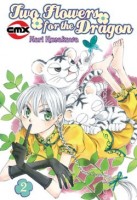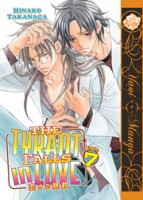My News and Reviews
I only posted one review last week, but there were a couple of other posts as well. As for the review, I took a look at Haruki Murakami’s award-winning Kafka on the Shore. Of the two Murakami novels that I have so far read, this is my favorite. Still, at times I found it to be a rather frustrating reading experience, although there were parts of the novel that I absolutely loved. For the few people who are actually interested, I also posted January’s Bookshelf Overload last week. But, perhaps most importantly, my first manga giveaway of the year is currently in progress! I accidentally ended up with two copies of the second Vinland Saga omnibus, so now you have a chance to win one for your very own! The winner will be announced on Wednesday, so there’s still some time to enter the giveaway.
On to other things online! Matt Thorn has tracked down the interview with Inio Asano that sparked the whole discussion about his gender identity among fandom and offers some of his own comments. Over at All About Manga, Daniella Orihuela-Gruber writes about Hetalia’s Version of History: What Does It Offer Readers?. The fourth episode of Fujojocast has been posted, which takes a look at some award-winning and award-nominated manga. And speaking of honor-worthy manga, Wandering Son made the Rainbow List again this year and quite a few manga appear on YALSA’s 2014 list of Great Graphic Novels for Teens (which is actually a great list of graphic novels for anyone, not just teens). Finally, Seven Seas has had a week full of license announcements, including Vampire Bund doujinshi, Kokoro Connect, and it’s newest yuri acquisition Citurs.
Quick Takes
 Attack on Titan, Volume 11 by Hajime Isayama. To be honest, I’ve recently been a little worried reading Attack on Titan due to the sheer number of plot twists that seem to be included in every volume. While this does make for some exciting (and occasionally confusing) storytelling, it also makes the series feel like Isayama barely has it under his control. Fortunately, the eleventh volume of Attack on Titan is relatively the free of any “big reveals.” (At least in comparison to previous volumes.) Instead, the characters must deal with the fallout from some of the most recent developments—there are a surprising number of Titans who have come out of the 104th Corps. So, while there aren’t many dramatic plot twists in the eleventh volume, there is a major Titan battle between Eren and some of the people he once considered to be his comrades. Some nice character development comes out of it, too, as well as some more hints regarding what the Titans really are and who is behind it all. I’m still sticking with the series at this point.
Attack on Titan, Volume 11 by Hajime Isayama. To be honest, I’ve recently been a little worried reading Attack on Titan due to the sheer number of plot twists that seem to be included in every volume. While this does make for some exciting (and occasionally confusing) storytelling, it also makes the series feel like Isayama barely has it under his control. Fortunately, the eleventh volume of Attack on Titan is relatively the free of any “big reveals.” (At least in comparison to previous volumes.) Instead, the characters must deal with the fallout from some of the most recent developments—there are a surprising number of Titans who have come out of the 104th Corps. So, while there aren’t many dramatic plot twists in the eleventh volume, there is a major Titan battle between Eren and some of the people he once considered to be his comrades. Some nice character development comes out of it, too, as well as some more hints regarding what the Titans really are and who is behind it all. I’m still sticking with the series at this point.
 Sake Jock: Comics from Today’s Japanese Underground edited by Adam Glickman. Published in 1995, Sake Jock is described as being “the first collection of Japanese alternative artists to appear in English.” Sadly, this slim volume from Fantagraphics can be rather difficult to find nowadays. Sake Jock collects seven short manga, most if not all of which were originally published in the influential alternative manga magazine Garo. Some of the creators I was already familiar with from other underground comics anthologies while others I was encountering for the first time. I was particularly happy to see a work by Kiriko Nananan included since I love her style. Overall, I appreciated and enjoyed the manga collected in Sake Jock. I’m not sure that the collection will hold much general appeal except to those who already have an established interest in alternative manga; there have since been other anthologies published that would make a better introduction. It’s kind of a cool artifact, though, and I am glad to have it as part of my collection.
Sake Jock: Comics from Today’s Japanese Underground edited by Adam Glickman. Published in 1995, Sake Jock is described as being “the first collection of Japanese alternative artists to appear in English.” Sadly, this slim volume from Fantagraphics can be rather difficult to find nowadays. Sake Jock collects seven short manga, most if not all of which were originally published in the influential alternative manga magazine Garo. Some of the creators I was already familiar with from other underground comics anthologies while others I was encountering for the first time. I was particularly happy to see a work by Kiriko Nananan included since I love her style. Overall, I appreciated and enjoyed the manga collected in Sake Jock. I’m not sure that the collection will hold much general appeal except to those who already have an established interest in alternative manga; there have since been other anthologies published that would make a better introduction. It’s kind of a cool artifact, though, and I am glad to have it as part of my collection.
 Two Flowers for the Dragon, Volumes 2-4 by Nari Kusakawa. It’s actually been a few years since I read the first volume of Two Flowers for the Dragon, but I remember being quite taken with it so I figured it was about time to get around to reading more of the series. I’ve rediscovered that I really enjoy the manga. It’s a wonderful mix of fantasy and romance with great character dynamics. There’s also a bit of court intrigue and some assassination plots for good measure.(And some unexpected gender-bending, too, for that matter.) Shakuya, the princess and heir of the Dragon Clan, has two fiancés vying for her affections. Kuwan is a capable but somewhat arrogant captain of the guard while Lucien is a kind-hearted young man who has lost many of his memories. The two of them obviously care for her dearly and are understandably a little antagonistic towards one another. Much to her dismay, Shakuya has developed feelings for both of them to varying degrees. But trying to figure out the workings of her own heart is only one of her many concerns.
Two Flowers for the Dragon, Volumes 2-4 by Nari Kusakawa. It’s actually been a few years since I read the first volume of Two Flowers for the Dragon, but I remember being quite taken with it so I figured it was about time to get around to reading more of the series. I’ve rediscovered that I really enjoy the manga. It’s a wonderful mix of fantasy and romance with great character dynamics. There’s also a bit of court intrigue and some assassination plots for good measure.(And some unexpected gender-bending, too, for that matter.) Shakuya, the princess and heir of the Dragon Clan, has two fiancés vying for her affections. Kuwan is a capable but somewhat arrogant captain of the guard while Lucien is a kind-hearted young man who has lost many of his memories. The two of them obviously care for her dearly and are understandably a little antagonistic towards one another. Much to her dismay, Shakuya has developed feelings for both of them to varying degrees. But trying to figure out the workings of her own heart is only one of her many concerns.
 The Tyrant Falls in Love, Volume 7-8 by Hinako Takanaga. Volumes seven and eight of The Tyrant Falls in Love form the last story arc in the series although Takanaga does promise that she hasn’t completely abandoned the story and characters. She plans on creating more manga—side stories, epilogues, and so on—but The Tyrant Falls in Love forms a complete story on its own, even considering the fact that it was a sort of follow-up to her debut series Challengers. Throughout The Tyrant Falls in Love, Morinaga and Souchi’s communication has been absolutely terrible. Their relationship is an extraordinarily rocky and volatile one; I honestly wasn’t sure what sort of ending Takanaga was going to go for. Overall, I was very satisfied with the series’ conclusion and I think it works. The only thing I wasn’t entirely convinced by is the direction that Masaki’s relationship with Morinaga’s older brother seems to be taking. Granted, that particular development did set in motion a pretty critical realization on Morinaga’s part.
The Tyrant Falls in Love, Volume 7-8 by Hinako Takanaga. Volumes seven and eight of The Tyrant Falls in Love form the last story arc in the series although Takanaga does promise that she hasn’t completely abandoned the story and characters. She plans on creating more manga—side stories, epilogues, and so on—but The Tyrant Falls in Love forms a complete story on its own, even considering the fact that it was a sort of follow-up to her debut series Challengers. Throughout The Tyrant Falls in Love, Morinaga and Souchi’s communication has been absolutely terrible. Their relationship is an extraordinarily rocky and volatile one; I honestly wasn’t sure what sort of ending Takanaga was going to go for. Overall, I was very satisfied with the series’ conclusion and I think it works. The only thing I wasn’t entirely convinced by is the direction that Masaki’s relationship with Morinaga’s older brother seems to be taking. Granted, that particular development did set in motion a pretty critical realization on Morinaga’s part.















